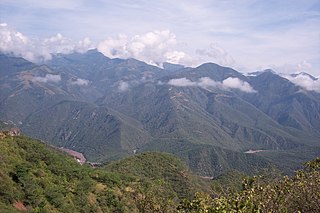
Tejano music, also known as Tex-Mex music, is a popular music style fusing Mexican influences. Its evolution began in northern Mexico.

Chicano rock, also called chicano fusion, is rock music performed by Mexican American (Chicano) groups or music with themes derived from Chicano culture. Chicano Rock, to a great extent, does not refer to any single style or approach. Some of these groups do not sing in Spanish at all, or use many specific Latin instruments or sounds. The subgenre is defined by the ethnicity of its performers, and as a result covers a wide range of approaches.

Sinaloa, officially the Estado Libre y Soberano de Sinaloa, is one of the 31 states which, along with Mexico City, comprise the Federal Entities of Mexico. It is divided into 18 municipalities, and its capital city is Culiacán Rosales.

The music of Mexico is highly diverse, featuring a wide range of musical genres and performance styles. It has been influenced by a variety of cultures, primarily deriving from Europeans, Indigenous, and Africans. Music became an expression of Mexican nationalism starting in the nineteenth century.
Furia Musical was a Mexican music magazine published by Editorial Televisa, which includes articles and gossip about the famous singers in this genre.

Norteño or Norteña, also música norteña, is a subgenre of regional Mexican music. The music is most often based on duple and triple metre and its lyrics often deal with socially relevant topics, although there are also many norteño love songs. The accordion and the bajo sexto are traditional norteño's most characteristic instruments.

KLAX-FM is an American commercial radio station located in East Los Angeles, California, broadcasting to the Greater Los Angeles area. It is owned by Spanish Broadcasting System (SBS). KLAX-FM airs a regional Mexican music format branded as "La Raza". The station has studios in Los Angeles, and its transmitter is based in Glendale.

Akwid is a Chicano rap group. Brothers Francisco "AK" Gómez and Sergio "Wikid" Gómez, who make up Akwid, are originally from Jiquilpan, Michoacán, but grew up in Los Angeles, California. Before becoming Akwid both "AK" and "Wikid" were part of a former rap group named the "Head Knockerz" with other group members Sabu and John Doe

Regional styles of Mexican music vary greatly from state to state. Norteño, banda, duranguense, Son mexicano and other Mexican country music genres are often known as regional Mexican music because each state produces different musical sounds and lyrics.
Regional Mexican music refers collectively to the regional subgenres of the country music of Mexico and its derivatives from the Southwestern United States. Each subgenre is representative of a certain region and its popularity also varies by regions. Subgenres include banda, country en Español, Duranguense, grupero, mariachi, New Mexico music, Norteño, Sierreño, Tejano, and Tierra Caliente. It is among the most popular radio formats targeting Mexican Americans in the United States.

"Footsteps in the Dark" is a 1977 slow jam recorded by The Isley Brothers as an album track featured on the group's album Go for Your Guns. It was the B-side to "Groove with You", which reached number 16 on the R&B singles chart. The song is noted for its unique guitar timbre which can be heard on other Isley Brother tracks such as "Voyage to Atlantis", as well as marking Ron Isley's growing transition into singing more ballads compared to the band's earlier funk approach.
Tierra Caliente music is a subgenre of regional Mexican music.

Grupera is a subgenre of regional Mexican music. It reached the height of its popularity in the 1990s, especially in rural areas. Grupera music traces its roots to the rock groups of the 1960s yet has evolved significantly over time. Typically performed by ensembles of four or more musicians, the genre prominently features electric guitars, Musical keyboards, and drums. The popularity of grupera music surged notably during the 1980s, propelling it into commercial viability and establishing its place within the Latin music landscape. Today, the genre is widely acknowledged and celebrated in prestigious Latin music awards ceremonies such as Lo Nuestro Awards and the Latin Grammy Awards, reflecting its enduring influence and cultural significance across Latin America and beyond. Grupera music is a distinct Mexican musical genre that blends traditional ranchera melodies with influences from norteño and other regional styles like corridos, cumbias, charangas, ballads, boleros and huapangos.
Banda Machos is a regional Mexican band from Villa Corona, Jalisco.
Banda Maguey is a Regional Mexican band from Jalisco, Mexico. They originated in Villa Corona, also the home of Banda Machos, who along with Banda Maguey have been called the two most successful exponents of the technobanda sound. Banda Maguey was led by their singer Ernesto Solano who has also composed a number of their songs, including Pero Te Amo, a hit from their fourth album, El Mundo Gira. In 1998, Banda Maguey signed a record deal with BMG U.S. Latin and recorded Lágrimas de Sangre.

The 1992 Southern California drywall strike was a strike by Mexican and Mexican American drywall hangers, many of whom were undocumented, for fair wages and health insurance from contractors, who stole two billion dollars a years in income taxes, social security, and worker's compensation payments from the workers and collaborated with the local police to repress the organizers. Jesus Gomez, leader of the strike, received threats and had shots fired at his home, while key organizers were tailed by the police and even followed with helicopters. Eventually aligning with the United Brotherhood of Carpenters and Joiners, the strikers succeeded in getting union contracts that ensured fair wages and benefits. The strike left the residential construction industry in a different state. While the industry remained an open shop, contractors were forced to pay Mexican workers with wages and benefits closer to that of the white workers.

Mexican Americans have lived in Los Angeles since the original Pobladores, the 44 original settlers and 4 soldiers who founded the city in 1781. People of Mexican descent make up 31.9% of Los Angeles residents, and 32% of Los Angeles County residents.
Bobby Espinosa was an influential and important part of the Latin rock scene in Los Angeles from the late 1960s to the 2000s. He was a founding member of El Chicano.
Banda Arkángel R-15 is a Regional Mexican band founded by Jesus Navarro in Las Varas, Nayarit in 1992. The band is one of the best known in the Technobanda genre. The R15 in the band's name represents a type of assault riffle commonly known in the banda mafia genre. Their record labels were Fonovisa (1990-1998), Sony BMG (1999-2003), and Caro Music (2006-).
Felipe Valdés Leal was a Mexican composer, lyricist, and artistic director. Valdés Leal grew up enjoying ranchera music and in 1923, he relocated to Los Angeles, California to pursue a career in music. He worked at a record store, where he would engage in humming, subsequently transcribing lyrical content to accompany them. His first successful compositions were the whimsical track "Échale un Quinto al Piano" and "Lucio Vázquez", a recording that garnered particular acclaim among the Latino community. By 1925, Valdés Leal became the artistic director at Brunswick Records, a pivotal role he played in catapulting the careers of Javier Solís, Irma Serrano, Los Panchos, and Los Alegres de Terán. In 1947, he became the artistic director for CBS Records.










